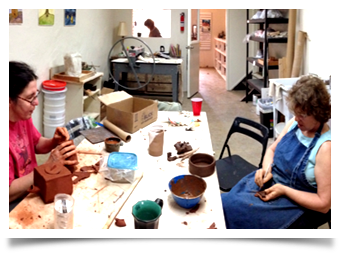TV Worth Watching: Craft In America
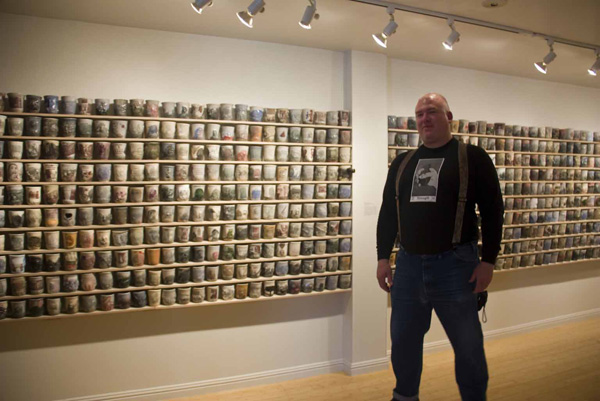
Craft in America, a PBS series, “explores America’s creative spirit through the language and traditions of the handmade.”Each of the more than dozen episodes is a thoughtful compilation of makers’ stories around a theme, for example teaching, origins, memory, and community. Included among the craft folk are more than 30 potters and ceramic artists.
Tune in to learn about some of the late greats including Harrison McIntosh, Peter Voulkos, and Warren MacKenzie, as well as younger ceramicists such as Nikki Lewis and Travis Owens. For an insightful segment that will perhaps leave you musing about your own pottery and its potential meaning, see what motivates former Marine Ehren Tool in the episode called “Service.”
Craft in America is a Los Angeles based non-profit. The organization’s creator, Carol Sauvion, is the director of Freehand, a Los Angeles gallery on 3rd Street that has specialized in functional craft since 1980.
Good Read
 This book describes the author’s two-year apprenticeship to Kazy Nagayoshi, a master potter from Miyama, Japan. Miyama, located at the southern tip of the islands of Japan, was originally settled by Korean potters brought to Japan at the beginning of the 17th century. At the time of Philip’s visit in the early to mid 1980s it was still home to a dozen potters. Philip’s memoir provides a fascinating glimpse into the life of a young potter learning a craft, and the culture of a small Japanese village.
This book describes the author’s two-year apprenticeship to Kazy Nagayoshi, a master potter from Miyama, Japan. Miyama, located at the southern tip of the islands of Japan, was originally settled by Korean potters brought to Japan at the beginning of the 17th century. At the time of Philip’s visit in the early to mid 1980s it was still home to a dozen potters. Philip’s memoir provides a fascinating glimpse into the life of a young potter learning a craft, and the culture of a small Japanese village.
KCET’s Documentary: “Heath Ceramics-The Making of a California Classic”
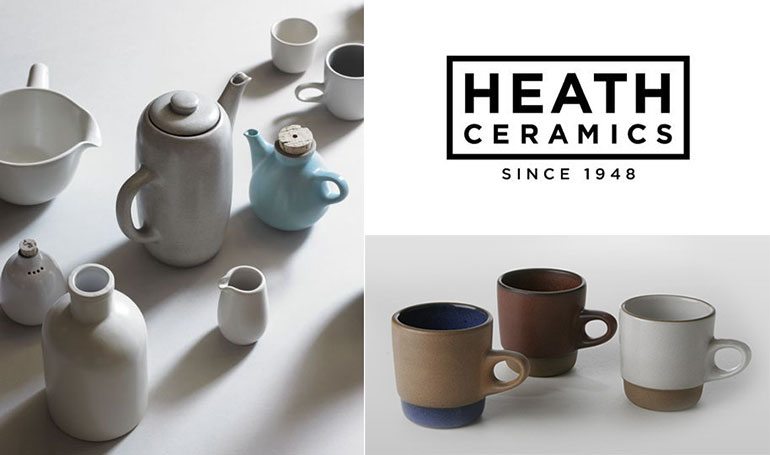
KCET’s program “Artbound” looks at the dinnerware of Heath Ceramics and a design that has stood the test of time since the company began in the late 1940’s. Through the writings of Edith Heath, the founder and designer of Heath Ceramics and voiced by renowned chef Nancy Silverton, this episode explores the groundbreaking work of a woman who created a classic of American design.
Greetings From Liz & Patty!
We hope this newsletter finds you and your loved ones healthy and safe at home. We are looking forward to welcoming you back when the time is right!

In the meantime we encourage you to keep moving forward with your passion for clay. We tend to focus on practicing our throwing and hand building skills when we’re at the studio. Perhaps this is a good time to turn our attention to form and decoration. What forms inspire you? What surfaces speak to you?
Watching masters make pottery is a great way to continue learning. Luckily there are thousands of helpful videos online, and many potters are doing live demonstrations on social media. There’s even TV for potters (see below).
Pinterest is a fun way to explore your taste and preferences. You can start your search with a general term (e.g. “pottery”) or specific maker (e.g. “Gertrud Natzler”) and save images of pieces you like. Once you’ve gathered a few hundred Pins, click on the plus sign to create two new boards called “Forms” and “Surface Design.” Copy your saved Pins that relate to form or surface design onto those boards. When finished take a look back and see what you can learn about the forms, glaze and decoration that inspire you.
“Techniques are difficult enough to learn, but the real difficulties begin when you know these techniques, and with them try to express what you think and feel.” –Marguerite Wildenhain

Good Read

But it also details Johnston’s most recent monumental project, a permanent installation at the North Carolina Museum of Art. The project required Johnston to engineer and construct heavy duty wheels on a scaffold as well as an oversized kiln in order to make 178 wood fired pillars standing between just inches and to over six feet tall. “I’m ready to move on, and I’m not scared about the world. It’s wide open,” Glassie quotes him as saying towards the end of the book.
Johnston’s discovery of his own abilities is inspirational, maybe even for us every day potters struggling with a bigger shape or new technique.
Signed Copies of Glassie’s book are available with a stein or mug made by Johnston for $100, perhaps the perfect gift for your favorite potter. (Or yourself!)
Good Read
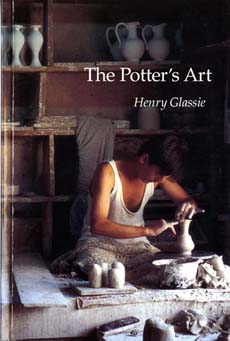
“It is good to be a potter. At work, the potter manages the transformation of nature, building culture while fulfilling the self, serving society, and patching the world together with pieces of clay that connect the past with the present, the useful with the beautiful, the material with the spiritual.”
So writes Henry Glassie, author of “The Potter’s Art” (1999, Material Culture of Philadelphia/Indiana University Press). This good read takes us into the studios of master potters in the United States, Sweden, Turkey, Bangladesh, and Japan, illustrating the common experiences that link them.
To see the transformation of nature Glassie references, you might like to watch Primitive Technology: Tiled Roof Hut, in which John Plant makes and fires tiles in the Australian bush using only primitive tools and materials. Or watch a bit of Javad Mahrbannia’s video, which shows in great detail an elderly Iranian woman’s creation of functional vessels.using traditional techniques. Meanwhile Matthew Weir and Jerry Duller’s A Bizarre and Noble Craft documents how two brothers carry on their father’s craft in Andalusia, holding on to their tried and true methods but adapting their store to modern times.
Good Read
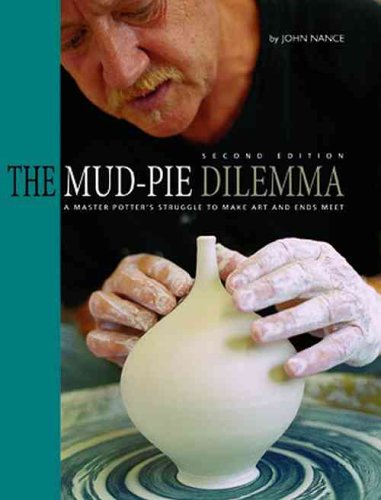
The Mud-Pie Dilemma, the true story of Tom and Elaine Coleman and their struggles to create a successful, loving marriage and family while master potter Tom seeks to realize his extraordinary potential as a ceramic artist. The first edition of this book by writer and photojournalist John Nance ended with the Colemans achieving high artistic and critical success, and low financial rewards. The second extends their story from 1977 to 2002, from a farmhouse and studio in Canby, Oregon, to a house with a swimming pool and studio in the desert outside Las Vegas, Nevada. Insightfully illustrated with photographs throughout.
Grandes Maestros: Great Masters of Iberoamerican Folk Art
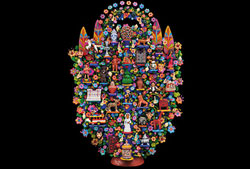
November 9, 2014 through September 13, 2015 at the Los Angeles County Natural History Museum.
More than 1,200 folk art works associated with daily use or ritual purposes are on display. The craftsmen (and women) featured molded clay, carved wood, blew glass, and fashioned intricate pieces from plant fibers, paper, leather, silver, beads, sheslls, gourds, and stones. One of the interesting things about this exhibit is that it is organized into sections that spotlight the raw materials, which means we clay lovers may be able to head straight for the goods!
Peter Voulkos: Sulpture, Pottery, Prints
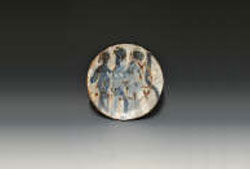
A collection of Voulkos works spanning the period from 1954-2000 is on exhibit at the Frank Lloyd Gallery at Bergamont Station from January 3-February 14, 2015. Voulkos, whose work blurred the line between fine art and craft, has inspired ceramicists to push the bounderies of what is possible with and expected from clay.
Meghan Smythe: A Swollen Light Behind the Eye
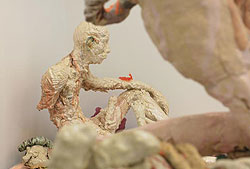
In her first solo show, ceramic artist and sculptor Meghan Smythe derives inspiration from James Arthur Baldwin’s theory of dishonest sentimentality. She explores the process of recounted memory, as well as emotion’s tendency to obfuscate motive. Smythe was the Visiting Artist in Residence at California State University, Long Beach (CA) from 2012-2014, and continues to teach ceramic arts there. Through Feb. 14. For information and hours, visit www. markmooregallery.com.
Raku: The Cosmos In A Tea Bowl
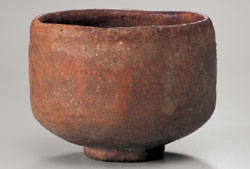
Los Angeles County Museum of Art, Pavilion for Japanese Art from March 29-June 7, 2015
Nearly 100 raku masterpieces dating from the 1500s are on display, including more than 50 chawans. This exhibit is the first of its kind in the United States, and LACMA is its only US venue.
For information and hours, go to http://www.lacma.org/art/exhibition/raku-cosmos-tea-bowl
Honoring the Past, Embracing the Future
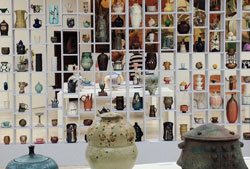
American Museum of Ceramic Art (AMOCA), 399 N. Garey Ave., Pomona, CA 91767, from February 21-June 28, 2015
AMOCA’s 10th anniversary exhibition featuring art from the museum’s permanent collection. The must-see show includes pieces from high points in the history of ceramics, with a focus on the 19th Century to the present. The pieces are beautifully displayed in the gallery. There is a spectacular wall of small works by a who’s who of ceramic artists that will keep you spellbound.
For information and hours, go to http://www.amoca.org/10th-anniversary-exhibition/]
Ralph Bacerra: Exquisite Beauty
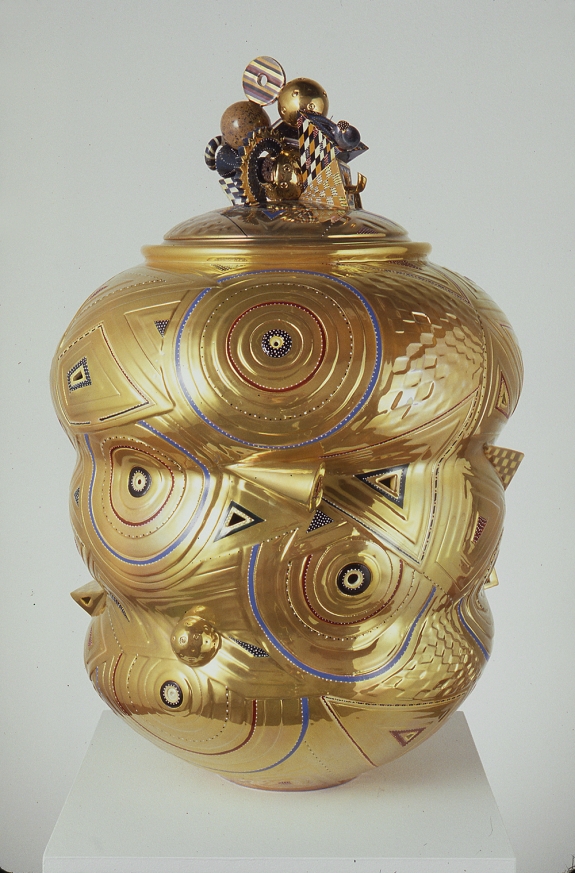
September 26-December 6, 2015
Opening Reception: September 26, 4-6 pm at Otis College of Art and Design, 9045 Lincoln Blvd., Los Angeles, CA 90045
Exquisite Beauty is the first retrospective and publication to document the ey-dazzling ceramics created by Ralph Bacerra (1938-2008), a Los Angeles-based artist known for his innovative approach to surface embellishment. Curated by Jo Lauria, the exhibition features more than 90 of the artist’s finest pieces — dramatic, highly decorated vessels and sculptures that have never before been the focus of a major exhibition or publication.
Click here for more information about this exhibit.
About Face: A Mixed-Media Celebration of Portraiture
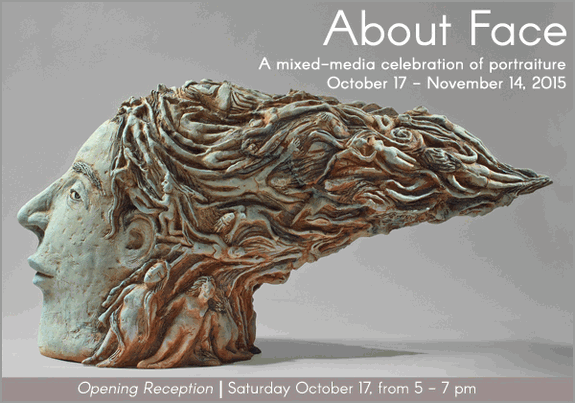
October 17-November 14, 2015
Opening Reception: Saturday, October 17, 5-7 pm, 8413 W. 3rd Street, Los Angeles, CA 90048
About Face features artists Isa Beniston, Kiai Brown, Heinz Brummel, Chinlee Chang and Terry Rothrock, Michael Carney, Gina Lawson Egan, Susan Garson, Hiro Hara, Diane Kamater,Thomas Mann, Michael Rohde, Leslie Rosdol, Rob Watt, Dave and Roberta Williamson.
Above: “Swept Away” by Gina Lawson Egan, photo by Gene Ogami
Chaos & Control 2015: Jay Kvapil
November 7-December 23, 2015
Opening Reception: Saturday, November 7, 6-8 pm, 166 N. La Brea Ave, LA, CA 90036
Jap Kvapil is the Dean of the Mike Curb College of Arts, Media, and Communication at CSUN. His work in ceramics shows deep meditation on the relations of Asian and American art — on the delicate shapes and intimate scale of the tea ceremony (which he studied at Takatori Seizan Pottery in Kyshuin, Japan), as well as the richly textured and organic shapes of mid-century American expressionism
Matt Wedel: Peaceful Fruit
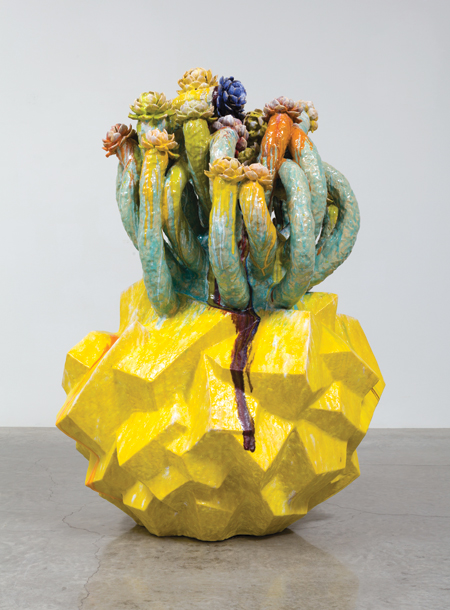
18 November 2015 – 30 December 2015
The exhibition features over two dozen free-standing and wall-mounted ceramic sculptures, awash in color and ranging in scale from 17 inches (5.2 cm) to nearly 7 feet (5 m) tall. This is the artist’s second solo show at L.A. Louver. “The title Peaceable Fruit comes out of a larger interest in landscape within my work and is a kind of hopeful signifier and idealized blueprint in understanding the future of humanity.” – Matt Wedel. To see a video about the artist and exhibit, click here.
Louver, 45 North Venice Boulevard, Venice, CA, USA. Gallery hours: Tues – Sat / 10am – 6pm. Tel: 310-822-4955
Edmund De Waal — Ten Thousand Things
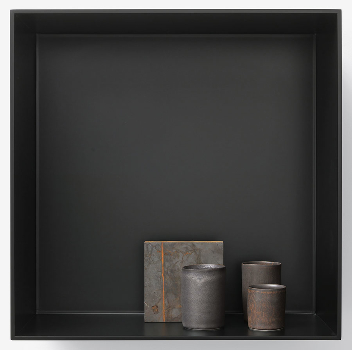
JANUARY 14-FEBRUARY 18, 2016
Gargosian Gallery
456 North Camden Dr., Beverly Hills, CA 90210
De Waal draws inspiration from many sources, including the poetry of Paul Celan and the musical compositions of John Cage. The exhibition title “Ten Thousand Things” derives from a longer phrase by cage about work, endless repetition, and unfolding, a citation inspired by the Taoist metaphor of indefinite multitude. In De Waal’s work, this is borne out in sequences of thrown porcelain vessels glazed in shades of white, cream, celedon and a newly developed palette of textured, metallic black glazes contained by various framing devises in steel and aluminum.
A to Z: AMOCA’s Permanent Collection
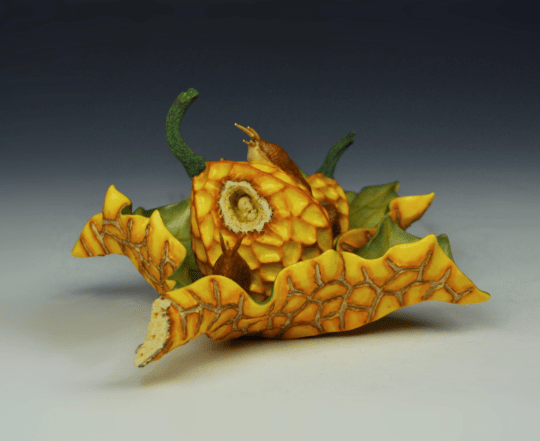
Exhibition Dates: July 9 – December 23, 2016
Opening Reception: Saturday, July 9, 5:00-8:00pm
399 North Garey Ave. Pomona, CA 91767
Keisuke Mizuno, Forbidden Fruit, 1998, Gift of Gail M. & Robert A. Brown
The American Museum of Ceramic Art (AMOCA) is proud to present Ceramics A to Z: AMOCA’s Permanent Collection.
Clay has been part of human culture for centuries, but it was not until the 8th century that the first alphabet was introduced. Just as the letters are the building blocks of the alphabet, letters also symbolize the building blocks of AMOCA’s collection. Each of the 26 letters of the alphabet will be used to highlight topics in AMOCA’s permanent collection with a focus on geography, techniques, and artistic styles.
While the vocabulary of ceramics cannot be limited to just 26 topics, we will use this exhibition to share the rich and diverse range of ceramics works in AMOCA’s permanent collection.
Chinese Ceramics from LACMA

January 24 – July 22
Vincent Price Art Museum, 1301 Avenida Cesar Chavez, Monterey Park, CA 91754
tel. 323-265-8841; http://vincentpriceartmuseum.org
This exhibition, comprising works from LACMA’s permanent collection, presents an introduction to Chinese ceramics, with examples from c. 2500 BC (Neolithic period) to the 19th century. The first section provides a survey of the technical development of Chinese ceramics, including the three basic types of clay—earthenware, stoneware, and porcelain—and decorative techniques, such as glazing. The second section focuses on some of the symbols and narratives embedded in the decoration of Chinese ceramics, including designs key to understanding Chinese cosmology, religion, history, and society. The exportation of Chinese ceramics to other parts of Asia began as early as the seventh and eighth centuries, and to Europe in the sixteenth century. The third section of this exhibition presents ceramics exported to Japan, Southeast Asia, the Near East, Europe, and the Americas between the fourteenth and nineteenth centuries.
ROSE CABAT: Memorial Exhibition
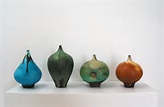
January 14 – February 25, 2017
Couturier Gallery, 166 N. LA BREA AVENUE LOS ANGELES, CALIFORNIA 90036
tel. 323-933-5557; www.couturiergallery.com
Couturier Gallery is pleased to present ROSE CABAT Memorial Exhibition featuring 46 of Rose Cabat’s famous jewel-like porcelain Feelies, so called because of their seductively tactile and visually alluring, satiny glazes, which beckon to be touched. The majority of the Feelies on view were produced in the 1960s and stored in boxes and closets for decades, never seen before until now. Rose Cabat (1914-2015) was born in the Bronx and was an indefatigable perfectionist who produced ceramic works until three months before she died in January 2015.
